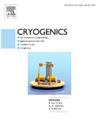Performance characterization of a 20 K, High-Capacity cryocooler for Cryo Fluid Management
IF 2.1
3区 工程技术
Q3 PHYSICS, APPLIED
引用次数: 0
Abstract
Future NASA mission architectures for travel to and habitation of the Lunar and Martian surfaces will require the capability of zero-boil-off storage and liquefaction of hydrogen. To intercept the projected heat loads on the cryogen tanks or to liquefy, a high capacity cryocooler providing refrigeration at 20 K is required. In addition to the refrigeration requirements, high overall efficiency is required to remain within overall size and power constraints. Creare developed and recently demonstrated a high-capacity turbo-Brayton cryocooler to meet these requirements and to support future NASA mission initiatives. The cryocooler is a single-stage turbo-Brayton cryocooler designed to produce 20 W of refrigeration at 20 K and reject heat at 270–300 K. Thermodynamic characterization testing demonstrated up to 22.5 W of refrigeration at 22.7 K and up to 21.4 W of refrigeration at 20 K. The maximum cryocooler COP was 16 % of the Carnot cycle at a 285 K heat rejection temperature and the minimum specific power was 80 W/W. The cooling capacity and performance of this cryocooler are new benchmarks for 20 K cryocoolers for space. This paper reviews the thermodynamic performance characterization testing of the cryocooler.
性能表征的20 K,高容量制冷机的低温流体管理
未来NASA在月球和火星表面旅行和居住的任务架构将需要氢的零蒸发储存和液化能力。为了拦截在冷冻罐上的投影热负荷或液化,需要一个提供20 K制冷的高容量制冷机。除了制冷要求外,还需要在总体尺寸和功率限制内保持高整体效率。Creare开发并最近演示了一种高容量涡轮布雷顿制冷机,以满足这些要求,并支持未来NASA的任务计划。制冷机是单级涡轮-布雷顿制冷机,设计用于在20 K时产生20 W的制冷,并在270-300 K时排出热量。热力学表征测试表明,在22.7 K和20 K下,制冷功率分别为22.5 W和21.4 W。在285 K的排热温度下,制冷机的最大COP为卡诺循环的16%,最小比功率为80 W/W。该制冷机的制冷量和性能是空间20k制冷机的新基准。综述了低温冷却器的热力学性能表征试验。
本文章由计算机程序翻译,如有差异,请以英文原文为准。
求助全文
约1分钟内获得全文
求助全文
来源期刊

Cryogenics
物理-热力学
CiteScore
3.80
自引率
9.50%
发文量
0
审稿时长
2.1 months
期刊介绍:
Cryogenics is the world''s leading journal focusing on all aspects of cryoengineering and cryogenics. Papers published in Cryogenics cover a wide variety of subjects in low temperature engineering and research. Among the areas covered are:
- Applications of superconductivity: magnets, electronics, devices
- Superconductors and their properties
- Properties of materials: metals, alloys, composites, polymers, insulations
- New applications of cryogenic technology to processes, devices, machinery
- Refrigeration and liquefaction technology
- Thermodynamics
- Fluid properties and fluid mechanics
- Heat transfer
- Thermometry and measurement science
- Cryogenics in medicine
- Cryoelectronics
 求助内容:
求助内容: 应助结果提醒方式:
应助结果提醒方式:


